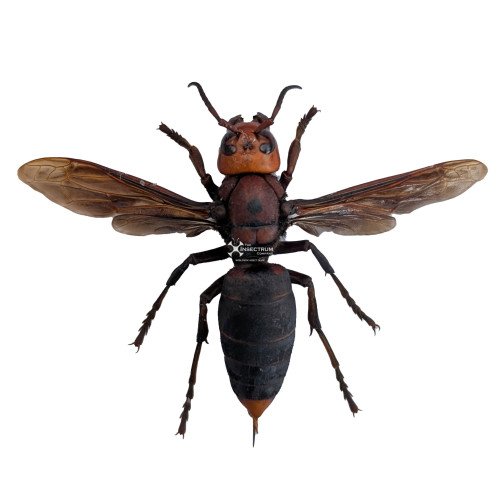
The Asian giant hornet (Vespa mandarinia) is the world’s largest hornet, with workers measuring around 2 inches (5 cm) long. It has a striking appearance, with a robust body featuring a yellow-orange head, dark brown thorax, and an orange-and-black striped abdomen. Its clear wings span nearly 3 inches (7.5 cm), making it an intimidating sight. Native to East Asia, it has spread to regions like North America, notably in Washington State, where it has raised concerns due to its aggressive behaviour and potential threat to honeybee populations. The hornet’s sting is painful and can cause severe reactions in sensitive individuals. The name mandarinia is derived from the word "mandarin," referencing the hornet’s distribution in East Asia, historically associated with China’s mandarins or officials. A curious fact is that the hornet can release a potent pheromone, signalling other hornets to attack when threatened, making its defence mechanism highly effective.
We firmly support the sustainable tropical butterfly collections as long as they take care of the conservation of the rainforest where they fly and the development of responsible conscious trading. This allows us to support local ranching farms with ethically sourced material and help at the same time collectors and enthusiasts to contribute to understanding and treasuring those species.
Please take into consideration that the specimen that you will receive may slightly differ in size, shape or colour from the picture shown as you are purchasing a natural product.
All our items are carefully delivered to prevent damages on transport, papered items are packaged in glassine envelopes specifying capture/breeding data and location available. CITES certificate will be provided in the specimens required.
HOW WE GRADE OUR LISTINGS (SPECIMENS)
As Insect specimens are natural products, some are bred and some others caught in wild, the quality can vary greatly.
The guide below explains the grading used for specimens in our listings.
A1 No visible imperfections, both antennas, no tearing, scratches or missing part of the wings (or as perfect as you could expect from wild caught specimens), with exception of some leg damage.
A1- Very minor damage, normally restricted to antenna damage or antennae attached separately in the envelope.
A- These specimens have minor damage, such as antenna damage, or minor flight wear such as small scratches, minor sale damage, some minor fraying/chipping around the edges of the wings.
A2: More significant damage, such as major flight wear, small rips, small pieces missing from the wings, damage to the thorax or abdomen.
B or Second Grade These specimens have similar damage to A2 specimens, but to a more significant degree. Usually used as parts replacement or art work material
| SPECIMEN | |
|---|---|
| Country | China |
| Locality | Yunnan Prov |
| Collection type | Wild collected |
| Bio-zone | Indomalayan |